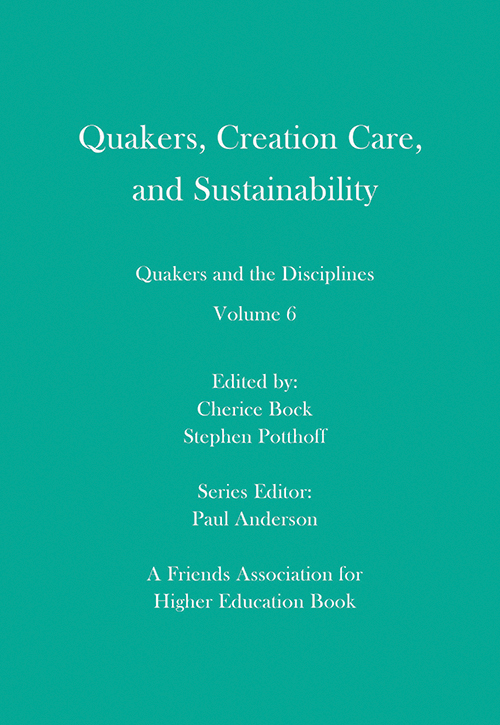
Quakers, Creation Care, and Sustainability (Quakers and the Disciplines, Volume 6)
Reviewed by Ruah Swennerfelt
October 1, 2020
Edited by Cherice Bock and Stephen Potthoff. Friends Association for Higher Education, 2019. 478 pages. $19.95/paperback; $9.95/eBook.
This comprehensive history looks at Quakers up to the current day through the lens of care for creation. Although for the past three decades I’ve worked for and volunteered in service to the earth and justice, I learned much from reading this fascinating book. Twenty-seven contributors, representing all the branches of Quakerism, share their historical understandings and personal stories with enthusiasm and depth. The book is separated into four parts, looking at ecological themes in Quaker history, the developing Quaker ecotheology, Quaker approaches to the environment in academic disciplines, and stories of those actively living Quaker ecotheology.
As an example of the breadth of sharing, S. Chagala Ngesa, a Kenyan Friend, tells of the merging of the indigenous traditions of the Maragoli and Quaker faiths. His grandmother was a Maragoli shaman and trained Ngesa to be a shaman as well. Their story is beautifully told.
I enjoyed learning about the Quaker colleges’ approaches to teaching ecotheology through theory and practice. In “Reclaiming Natural History: Quakers, Nature, and Education,” Guilford College professor James W. Hood describes a course he’s been teaching for the past five years entitled “Animal Stories of the Cape Fear River Basin.” The students learn by intimately exploring and experiencing the river basin in all sorts of weather. A quote in this chapter that spoke to me was from an essay by Thomas Lowe Fleischner:
Why does attentiveness to nature matter? In a very fundamental sense, we are what we pay attention to. Paying heed to beauty, grace, and everyday miracles promotes a sense of possibility and coherence that runs deeper and truer than the often illusory commercial, social “realities” advanced by mainstream contemporary culture.
Although space does not allow me to mention every contributor, I will mention a few more. My husband and I met Jon R. Kershner and his wife, Jessica, when he was pastor of a Friends church that was part of Northwest Yearly Meeting of Friends Church. We had been visiting Friends meetings and churches on the West Coast to bring awareness of the relevance of John Woolman’s message to Friends today. Jon Kershner’s and our interest in Woolman made for a great match, so I was delighted to read his contribution to this book. In his essay, Kershner explores Woolman’s deeply felt relationship to wilderness, explaining that Woolman believed that all physical spaces held the promise to be places of divine instruction and that a sensitive wanderer can be drawn into spiritual places of insight. Kershner writes, “Woolman brought to the wilderness, as he did to all physical spaces, an apophatic spirituality in which the divine will could fill his own.” Today we can draw on Woolman’s teachings in our own expressions of caring for creation.
Cherice Bock, one of the editors of this book, shares a fascinating interview with Craig Goodworth, a land-based artist, poet, and Quaker. Goodworth describes the place where his art and his physical labor meet as an ecotone, the transition between two landscapes. He includes photos of his land-based art that challenge us all to see that place of ecotone. Bock writes, “Goodworth invites Friends to ever-deepening communion with all life as embodied and creative beings-in-relation.” He encourages us to see all that lives with new eyes and open hearts.
In the last section of the book, we read about various Quaker organizations’ efforts to heal the planet. I’ve included a few examples here. We learn that Quaker Earthcare Witness, formed in 1987, recognizes that the Quaker vision of peace and equality is challenged by ecological stress and the injustices from harmful environmental actions. We read about how Earth Quaker Action Team in Philadelphia, Pa., reclaims the Lamb’s War for justice and sustainability today through Spirit-based, nonviolent direct action.
The essay about Friends Committee on National Legislation explains how its members lobby for an earth restored and how direct lobbying can be effective for change. We also read about how the evolving understanding of creation care has led Friends World Committee for Consultation to work on environmental concerns. The essay includes stories of Friends’ experiences of climate change around the world.
I can’t do justice to all the fine contributions to this book, but I can encourage all Friends and Friends meetings to read and discuss the broad range of understanding of creation care as an essential topic of our time.
Ruah Swennerfelt is a member of Middlebury (Vt.) Meeting. She and her husband, Louis Cox, are homesteaders and live in a solar house. They are attempting to live sustainably and lovingly on the unceded land of the indigenous Abenaki people.


